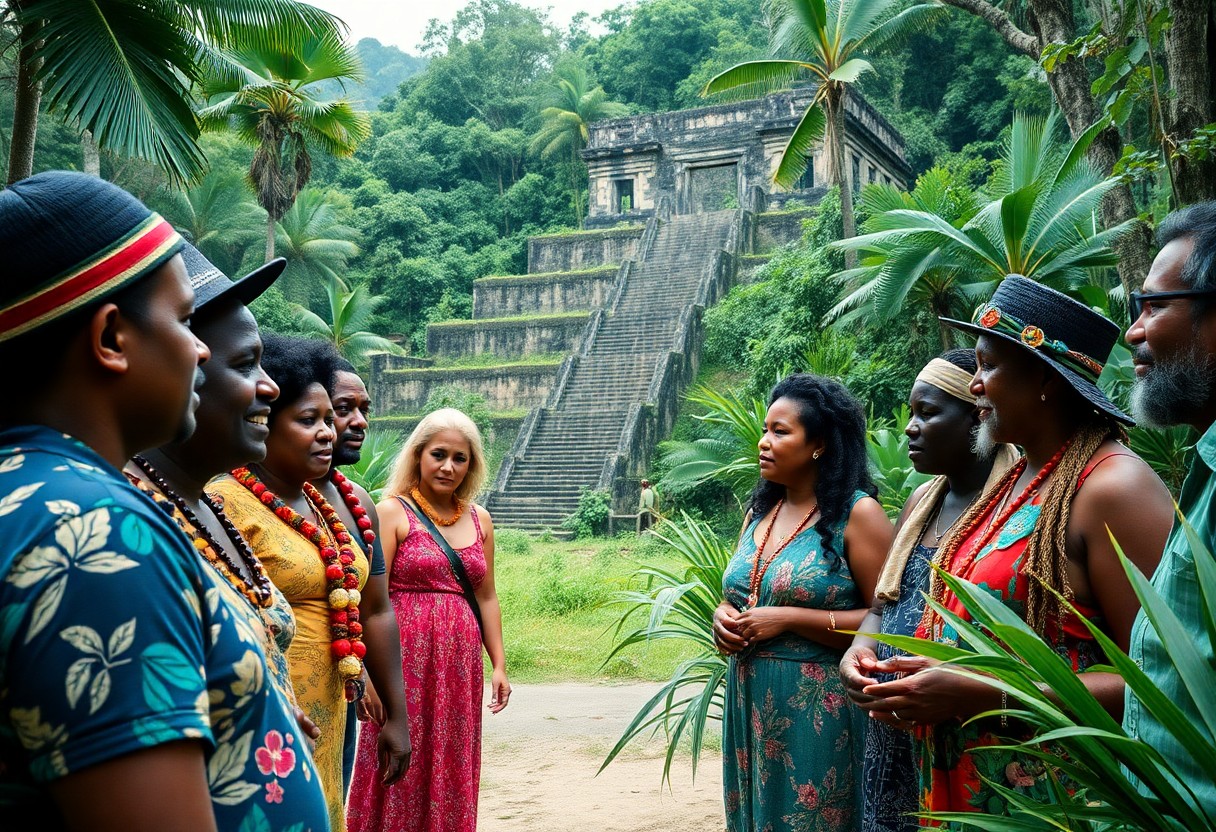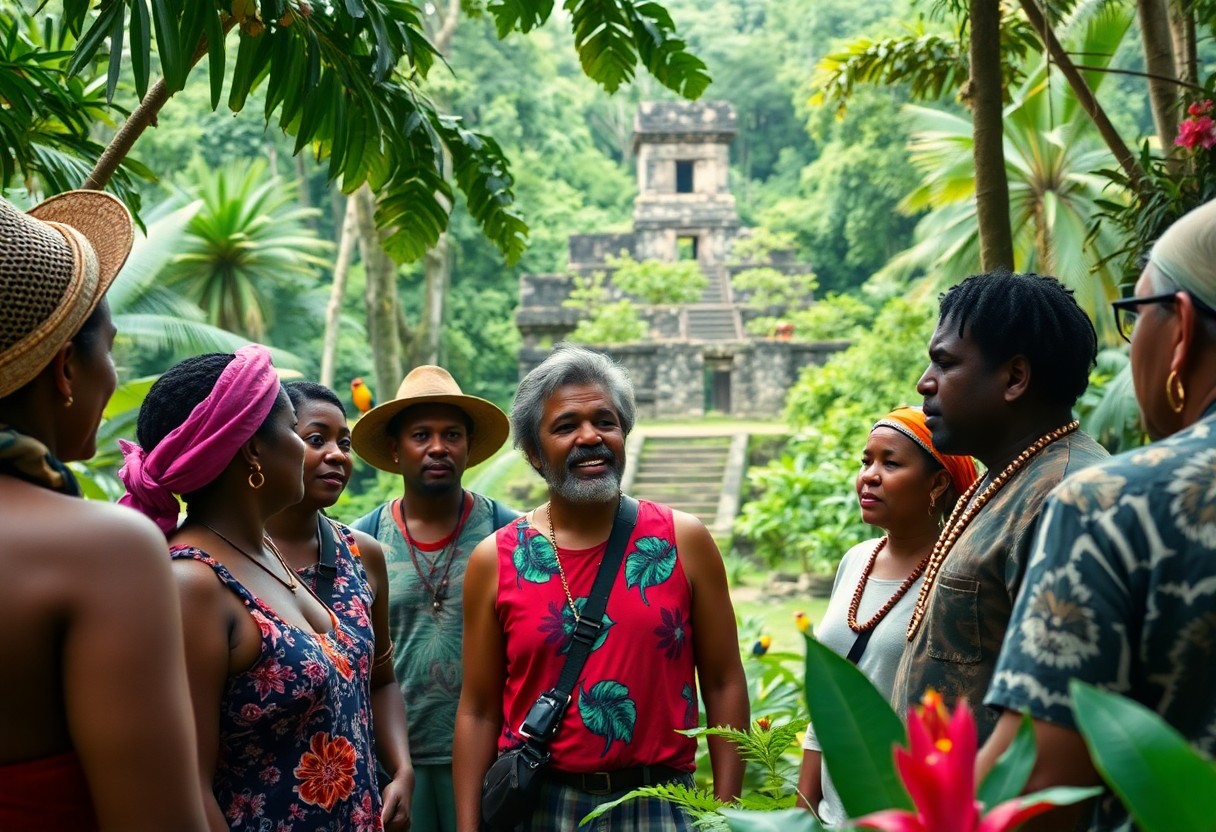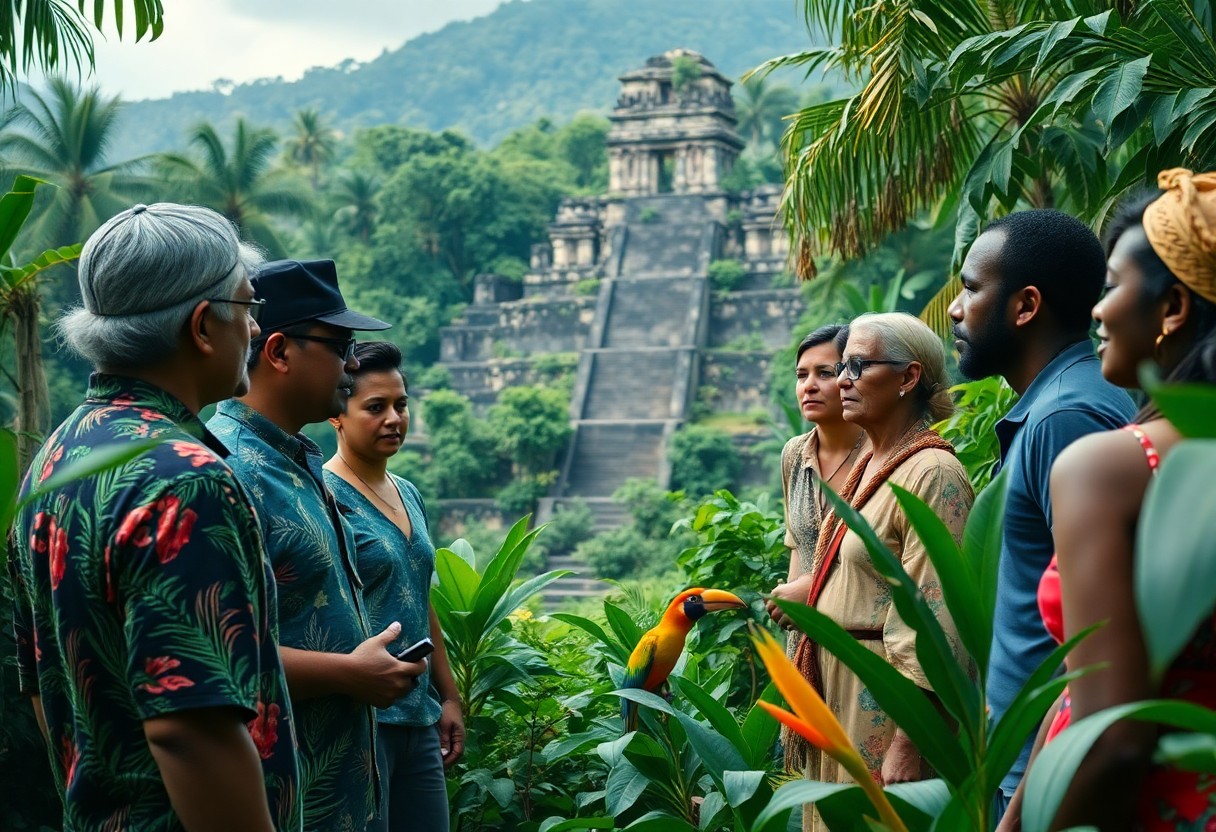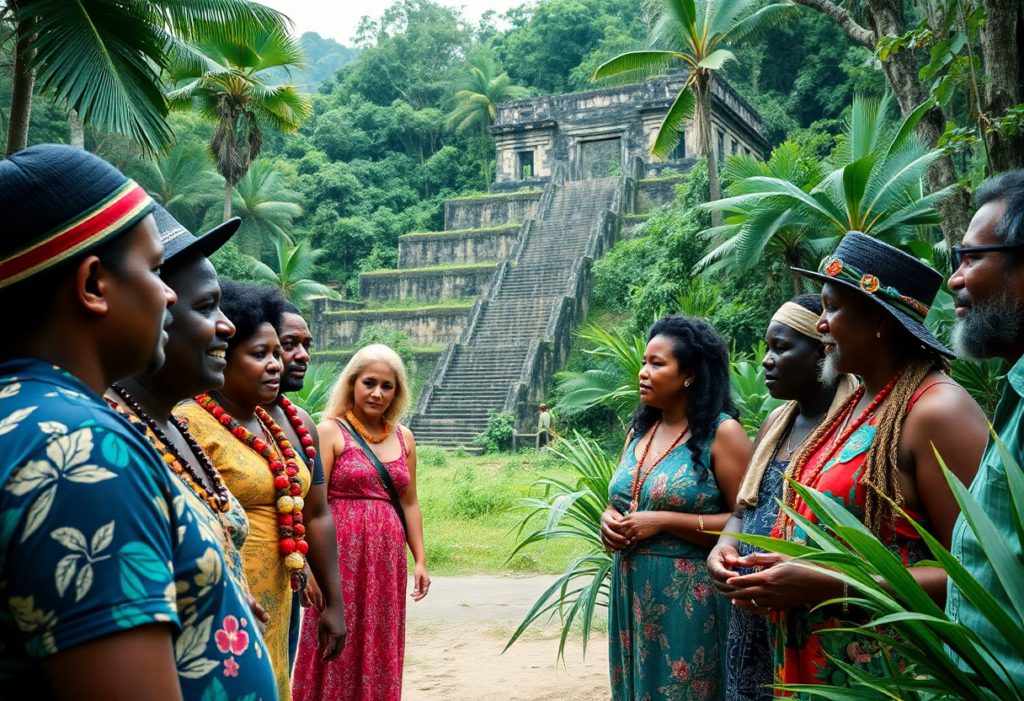Across the centuries, Belize has developed into a mesmerizing travel destination that captivates visitors with its extraordinary blend of cultural diversity and breathtaking natural wonders. In this enchanting nation, you'll immerse yourself in a society where English is the official language, yet a vibrant array of languages flourishes among Creole, Spanish, and Mayan communities. Your adventures will reveal a compelling historical narrative that spans ancient Mayan civilizations, the enduring legacy of British colonialism, and a lively modern identity. Furthermore, Belize's ecological diversity is astonishing, featuring unique ecosystems, including the world’s second-largest barrier reef and lush tropical rainforests that host endangered species. From its distinctive linguistic landscape to its incredible environmental treasures, Belize offers an unmatched adventure that showcases the essence of Central America.
Delve into the Intriguing Language Diversity of Belize
Belize is characterized by a captivating tapestry of linguistic diversity, showcasing a remarkable multilingual environment that reflects its rich cultural heritage. This nation is home to a harmonious coexistence of various languages, creating an engaging and dynamic means of communication across this vibrant Central American locale. This linguistic richness not only enhances social interactions but also deepens the cultural fabric of Belize, encouraging visitors to connect with its diverse communities and experience the unique linguistic expressions that define the country.
Discovering the Significance of English in Belizean Culture
At the core of Belize’s linguistic diversity is English as the official language, a legacy stemming from its British colonial past. You'll find English widely utilized in government, education, and media, acting as a unifying medium for the diverse population. This prevalent use of English fosters communication among various ethnic groups, promoting a shared understanding and nurturing a sense of national identity that bridges cultural divides. The prominence of English enhances Belize's appeal as a tourist haven, ensuring accessibility for international visitors seeking to explore its rich cultural and natural landscapes.
The Role of Spanish in Enriching Belizean Culture
Within the linguistic dynamics of Belize, Spanish plays an influential role, primarily spoken by Hispanic communities and immigrants from neighboring countries. You’ll encounter substantial Spanish-speaking populations, particularly in border areas and urban centers. As the second most widely spoken language, Spanish acts as a crucial link connecting Belize to its Central American neighbors, facilitating vibrant cultural exchanges and cross-border interactions. This linguistic presence enhances the cultural landscape, allowing for a rich blend of traditions and practices that mirror the historical ties of the region.
The Distinctive Nature of Belizean Creole Language
Belizean Kriol, or Spanish Creole, represents a unique linguistic fusion that resonates throughout the country. This language has developed from historical interactions between African and European populations, capturing the essence of Belize's multicultural heritage. Creole serves as a primary means of communication for many Belizeans, embodying the dynamic cultural exchanges that characterize the nation. It is a vibrant, expressive language that conveys the rich historical experiences and narratives of the diverse communities residing in Belize, making it an essential part of the Belizean identity.
Exploring the Cultural Significance of Garifuna Language
Diving deeper into Belize's linguistic tapestry, Garifuna emerges as a noteworthy language community. You’ll discover this Arawakan language spoken by indigenous populations along the southern coastal areas of Belize. Garifuna holds profound cultural importance, symbolizing the resilience and heritage of Afro-indigenous communities. You will come to appreciate how this language preserves unique traditions, songs, and historical narratives that enrich the vibrant tapestry of Belizean society. The cultural expressions of the Garifuna people, including their music and dance, further enhance the nation's diverse cultural offerings, inviting you to experience their heritage firsthand.

Unveiling the Complex Colonial History and Path to Sovereignty
Belize’s colonial history is a multifaceted narrative woven from European influence and indigenous resilience. Initially claimed by Spain, the territory came under substantial control by British settlers, who established logging settlements that transformed the area into a strategic outpost. These British colonizers laid the groundwork for economic systems focused on wood extraction, ultimately resulting in the formal establishment of British Honduras in 1862. This historical backdrop provides valuable insights into the social and political dynamics that have shaped contemporary Belize and its ongoing development.
Understanding the Historical Context of British Honduras
During its era as British Honduras, Belize underwent a unique confluence of cultural interactions that significantly influenced its identity. You would witness the coexistence of British settlers with Maya populations, descendants of African slaves, and a variety of ethnic groups. The colonial era brought about notable demographic transformations, with economic activities transitioning from logging to agricultural production, leading to a diverse social landscape. This rich historical context contributes to your understanding of modern Belizean identity, encapsulating the influences of various cultural narratives that continue to coexist within the nation today.
Tracing the Journey Toward Independence
Alongside the political movements of the mid-20th century, Belize’s path to independence was marked by diplomatic negotiations and regional tensions. You can appreciate how influential political leaders like George Price navigated intricate international relationships, especially with Guatemala, which laid territorial claims on Belizean territory. The journey to independence was fraught with challenges, involving intricate discussions with both the British government and neighboring countries. The achievement of independence on September 21, 1981, marked a peaceful transition from over a century of British colonial rule, underscoring the strategic diplomacy and national resolve that characterized Belize’s emergence as a sovereign nation.

Discovering Belize's Extraordinary Ecosystems and Biological Wealth
In Belize, the natural world reveals an exceptional array of ecological diversity that is truly unparalleled globally. The country’s geographical location creates a remarkable convergence of ecosystems, ranging from coastal marine environments to dense tropical forests. You’ll discover landscapes that seamlessly integrate Caribbean marine habitats with lush inland terrains, providing a stunning ecological experience that establishes Belize as a global biodiversity hotspot. This unique amalgamation of environments invites exploration and appreciation of nature’s intricate beauty, making it a prime destination for eco-tourism enthusiasts.
Diving into the Marvels of Coral Reef Ecosystems
As you journey along Belize’s coastline, prepare to be astonished by the world’s second-largest barrier reef system, which stretches approximately 300 kilometers. This magnificent marine ecosystem is home to an astonishing variety of coral formations, serving as a habitat for thousands of marine species. Your underwater explorations will reveal vibrant coral gardens, intricate underwater landscapes, and a complex marine environment that supports both ecological balance and breathtaking visual diversity. The conservation of this reef system is crucial for maintaining marine health and promoting sustainable tourism practices that benefit both local communities and the environment.
Immersing Yourself in the Lush Tropical Rainforests
At the heart of Belize, tropical rainforests cover nearly 60% of the nation’s land area. You’ll find yourself surrounded by rich, verdant landscapes brimming with exotic plant and animal life. These forests represent a vital ecological zone, serving as a sanctuary for numerous endangered species while supporting essential environmental processes. To fully appreciate Belize’s rainforests, it’s crucial to understand their complex ecological structure. These multilayered ecosystems encompass diverse vegetation layers, from the forest floor to the canopy. You’ll uncover intricate relationships between plants, insects, mammals, and microorganisms that create a delicate web of life, highlighting the invaluable role that rainforests play in climate regulation and resource provision.
Revealing the Incredible Biodiversity of Belize's Wildlife
The intersection of reefs and rainforests creates an extraordinary wildlife sanctuary where you’ll encounter remarkable species diversity. Belize is home to over 500 bird species, numerous mammals, and an impressive variety of reptiles and amphibians. Your journey through these diverse ecosystems will unveil a living museum of biodiversity. However, Belize’s wildlife embodies more than just a tally of species; these ecosystems are integral to global conservation efforts. You’ll find endangered species like jaguars, howler monkeys, and marine mammals taking refuge in these protected environments. The intricate balance of predator-prey relationships, migration patterns, and habitat conservation positions Belize as a global model for ecological stewardship and biodiversity management.

Celebrating the Vibrant Cultural Mosaic of Belize
Despite its modest size, Belize showcases a vibrant tapestry of ethnic diversity, featuring a remarkable blend of cultures, including Creole, Garifuna, Maya, Mestizo, and European descendants. You can explore a society where multiple languages coexist and traditions intertwine, creating a unique national identity that celebrates differences while fostering social harmony. This multicultural landscape provides you with an extraordinary glimpse into how diverse communities can live and thrive together, enriching the national narrative and contributing to the overall cultural richness of Belize.
Participating in Colorful and Dynamic Multicultural Festivals
Any visitor to Belize will be enchanted by the colorful and lively festivals that showcase the nation’s rich cultural heritage. You’ll have the chance to experience celebrations like Garifuna Settlement Day, where traditional music, dance, and historical reenactments unite communities in a spectacular display of cultural pride and unity. These festivals not only offer entertainment but also serve as crucial platforms for preserving cultural traditions, allowing both locals and tourists to engage with Belize's vibrant cultural identity and contribute to its ongoing legacy.
Indulging in the Rich Flavors of Belizean Cuisine
The culinary landscape of Belize reflects its multicultural roots, presenting you with a delectable fusion of flavors from various ethnic traditions. You’ll encounter dishes that amalgamate Maya, Creole, Caribbean, and Central American influences, resulting in a unique gastronomic experience that tantalizes your taste buds. A deeper exploration of Belizean cuisine unveils extraordinary culinary traditions that are distinctive and flavorful. You’ll discover dishes like gibnut (a local game meat), rice and beans accompanied by stewed chicken, and fresh seafood specialties that highlight the country's diverse cultural influences. Each recipe tells a story of migration, adaptation, and cultural exchange, adding depth to your culinary journey.
Experiencing the Evolving Sounds of Belizean Music
Above all, Belizean music serves as a dynamically evolving expression of cultural fusion. You’ll encounter rhythms that blend Caribbean, African, and Latin American influences, creating a unique soundscape that mirrors the nation’s diverse heritage. For instance, you’ll be captivated by the rich musical traditions of Belize, which include genres like Punta, Brukdown, and Reggae. These musical styles not only offer entertainment but also play a vital role in preserving cultural memories and narratives, serving as powerful mediums for cultural expression and identity in Belize.
Uncovering Belize's Tourism Potential and Natural Marvels
Many travelers are attracted to Belize for its remarkable combination of natural beauty and cultural richness. You’ll discover a destination that provides unmatched tourism experiences ranging from pristine Caribbean coastlines to verdant tropical rainforests. The country's diverse landscape presents visitors with unique opportunities to explore ancient Mayan ruins, vibrant marine ecosystems, and breathtaking national parks that showcase Belize’s extraordinary biodiversity. This blend of natural and cultural attractions positions Belize as a must-visit location for adventure seekers and culture enthusiasts alike.
Embarking on Thrilling Adventure Tourism in Belize
Tourism in Belize transforms the dreams of adventure seekers into exhilarating reality. You can explore world-class cave systems, navigate challenging jungle terrains, and engage in thrilling activities such as zip-lining, river kayaking, and mountain biking. The diverse topography of Belize ensures that you’ll discover heart-pumping experiences that test your limits while immersing you in stunning natural landscapes. Each adventure not only provides excitement but also fosters a deeper connection with Belize’s breathtaking scenery and rich ecosystems, making your visit unforgettable.
Embracing Eco-Tourism: A Sustainable Approach to Exploration
Throughout Belize, eco-tourism embodies a sustainable method of exploring the nation’s extraordinary environmental treasures. You’ll encounter carefully managed conservation areas that protect rare wildlife and preserve delicate ecosystems, offering immersive experiences that connect you directly with nature’s intricate systems. With a strong commitment to environmental preservation, Belize stands as a global leader in sustainable tourism. You’ll discover numerous protected areas, such as the Cockscomb Basin Wildlife Sanctuary, which provide unparalleled opportunities to observe diverse wildlife, including jaguars, tropical birds, and unique plant species. The country’s dedication to maintaining ecological balance ensures that your visit supports conservation efforts while delivering unforgettable, responsible travel experiences.
Addressing Environmental Challenges and Promoting Conservation
Despite its breathtaking natural beauty, Belize faces significant challenges that threaten its ecological and cultural integrity. Environmental degradation, economic pressures, and global climate change pose substantial risks to the nation’s delicate ecosystems and social structures. You’ll find that these challenges necessitate strategic, comprehensive approaches to safeguard and sustain Belize’s unique natural and cultural heritage. Ongoing efforts to address these pressing issues are critical for the future well-being of Belize and its inhabitants, ensuring that the natural and cultural treasures can be preserved for generations to come.
Recognizing Environmental Threats to Biodiversity and Ecosystem Stability
Preserving Belize’s biodiversity has become increasingly intricate. Deforestation, coral reef bleaching, and rising sea levels are direct threats that affect your understanding of the country’s environmental vulnerability. It’s essential to acknowledge that these challenges endanger not only wildlife but also the entire ecological balance of this remarkable nation. Understanding these threats is crucial for developing effective conservation strategies that ensure the survival of Belize’s unique ecosystems and the diverse life they support.
Cultural Preservation Efforts in a Rapidly Globalizing World
For Belize, maintaining cultural diversity is a delicate balancing act. Indigenous languages, traditional practices, and multicultural identities face the risk of erosion in an ever-globalizing world. You’ll observe how communities strive to protect their unique heritage against the pressures of modernization. Cultural preservation extends beyond mere conservation; it involves active community engagement, educational initiatives, and intergenerational knowledge transfer as essential strategies. Young Belizeans increasingly emerge as champions of their cultural narratives, documenting languages, revitalizing traditional crafts, and celebrating the rich tapestry of their multiethnic society. This proactive approach ensures cultural continuity while allowing for dynamic, contemporary expressions of identity.
Discovering Belize: A Destination of Distinctive Richness
Ultimately, you’ll find Belize stands as a remarkable destination where linguistic diversity, rich historical layers, and extraordinary ecological landscapes converge. You can appreciate how its unique blend of English, Spanish, Kriol, and Mayan languages reflects its complex cultural heritage. Your exploration reveals a country where ancient Mayan civilizations intersect with colonial influences and vibrant modern identities. As you delve into Belize’s biodiversity, you’ll uncover an ecological treasure trove featuring pristine rainforests, coral reefs, and an impressive array of wildlife, making this small nation a global conservation jewel. Understanding Belize means recognizing its extraordinary capacity to preserve cultural complexity while maintaining ecological integrity, inviting you to experience the magic of this unique Central American paradise.
Frequently Asked Questions about Belize's Cultural and Natural Treasures
Q: What linguistic characteristics set Belize apart from other Central American countries?
A: Belize is unique as the only English-speaking nation in Central America, with English serving as its official language. While Spanish, Kriol, and Mayan languages are also spoken, English reflects the nation’s historical ties to British colonial heritage. This linguistic distinction enhances international communication and sets Belize apart from its neighboring Spanish-speaking nations, making it accessible for a diverse array of visitors.
Q: In what ways does Belize’s historical background differ from other countries in the region?
A: Belize's history is exceptional as it was the only British colony in Central America, achieving independence in 1981. Unlike its neighbors, Belize underwent a peaceful transition from British rule and has established a democratic governance system. The country's multicultural composition, featuring Creole, Garifuna, Maya, and Mestizo populations, creates a rich and diverse social landscape that distinguishes it from other regional countries, contributing to its unique cultural identity.
Q: What aspects make Belize’s biodiversity particularly significant on a global scale?
A: Belize boasts extraordinary ecological diversity, with approximately 60% of its land area designated as protected wilderness. The Belize Barrier Reef, recognized as the second-largest coral reef system globally, supports incredible marine biodiversity. Additionally, the country’s rainforests provide habitat for numerous endangered species, such as jaguars, howler monkeys, and countless tropical birds, establishing Belize as a global hotspot for conservation and ecological research, attracting attention from scientists and environmentalists worldwide.
The Article What Makes Belize Unique? Language, History, and Biodiversity appeared first on Belize Travel Guide
The Article Belize’s Unique Language, History, and Biodiversity Explained Was Found On https://limitsofstrategy.com



Your exploration of Belize’s rich tapestry of cultures and languages is truly fascinating. Having visited, I found the linguistic diversity not only beautiful but also a window into the complex history of the country. It’s interesting how languages like Kriol, Spanish, and various Mayan languages coexist, reflecting the layers of influence throughout Belize’s history.
I find the linguistic landscape of Belize particularly fascinating, especially how it reflects the country’s rich history and multicultural identity. The coexistence of English, Creole, Spanish, and various Mayan languages not only highlights Belize’s colonial past but also demonstrates how diverse communities can flourish together. As someone who has always been interested in language as a living expression of culture, it strikes me how language can be both a unifying and a differentiating force in societies.
You’ve touched on such an important aspect of language and culture with your observations about Belize’s linguistic landscape. The way that English, Creole, Spanish, and various Mayan languages coexist there is indeed a microcosm of broader global dynamics, where colonial histories and indigenous cultures continuously interact and evolve.
I appreciate your thoughts on Belize’s linguistic diversity—it reminds me of how well that rich cultural backdrop is reflected in the unique experiences you can have in comparison with other destinations, like Aruba.
‘Belize vs. Aruba: Find Your Perfect Island Getaway’
https://bakinglifesspecialmoments.co.uk/belize-vs-aruba-find-your-perfect-island-getaway/.